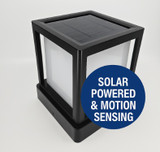The Most Energy-Efficient Lighting Options Today
When you're trying to have a 'greener' lifestyle at home or work, you tackle a few specific things. Recycling and composting is a popular first step. Switching to greener cleaning and construction materials often comes second. You might turn off certain electronics while you're out of the building or at night. But what about your lighting?
The U.S. Department of Energy tells us that around 22% of the all energy generated in the country is ultimately used for lighting. That's a big chunk. And it really benefits homes and businesses to reduce their electrical use for lighting. Not only is using less energy good for the environment, but it's also good for your wallet.
Tiny homes and other minimalistic living options are big, popularizing various kinds of off-grid lighting. Businesses are always looking to widen profit margins and score consumer favor points with green practices, so solar parking lot fixtures and roadway lighting are becoming common as well. Obviously harnessing the sun's natural energy (via solar lights or manipulation of sunlight with windows and building materials) is the MOST energy efficient method of lighting possible. You can't go wrong with free, readily available sunlight. But using solar and natural light isn't always an option. What then?
First of all, you want to choose Energy Star rated lighting. Most legitimate lighting companies these days offer Energy Star approved options on a large or small scale.
Compact fluorescent lights (CFL) used to be the standard energy efficient bulb. They're still relatively affordable today at a couple dollars per bulb. They have a few notable drawbacks that keep them from being the top dog of energy efficient lighting. First, they take a long time to reach full brightness, and often can't be dimmed with a switch or smart tech. Second, they don't last very long.
High powered LED lighting, on the other hand, has quickly ramped up to be the energy-efficient bulb of choice as LED tech has improved. LED arrays can be made in a variety of colors, shapes, and sizes, so almost anyone can find an LED design that fits their needs. On top of that, their longevity is just unbelievable. The overall cost for a single LED bulb can be pricey, especially compared to CFLs. But that price is an investment. Over time, LED bulbs save owners a ton of money. Why? They're not only efficient, but they also last around 50,000 hours. That's an 11-year lifespan for a bulb in use 12 hours every day. LED tech is constantly improving to make it more efficient and affordable, too.
So there you have it. Two top technologies, solar and LED, are being recognized for their environmental and financial prowess. Today, they're extremely affordable and common compared to just ten or twenty years ago. Soon, practically anyone will have access to these great technologies to light their homes and businesses.
Recent Posts
-
How Long Will Solar Powered Lighting Operate in the Rain?
How Solar Light Fixtures Can Run for 10 Rainy Days If you’ve ever wondered how a Commercial solar li …Jul 30th 2025 -
Spotlight - The IL-SPG54 Smart Solar Walkway Light: Where Performance Meets Simplicity
Introducing the IL-SPG54 Smart Solar Walkway Light: Where Performance Meets Simplicity When it comes …Jun 16th 2025 -
Corn Bulb Sale - While supplies last!
⚡ Limited Time Sale – BLE Series Corn Lamps Starting at $24.99! Stock up now while supplies last – p …Jun 11th 2025






